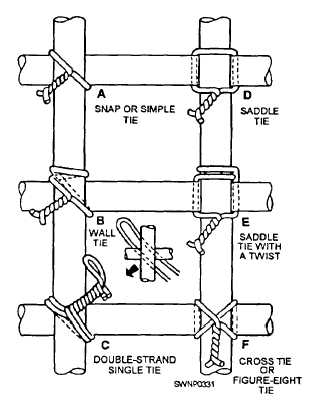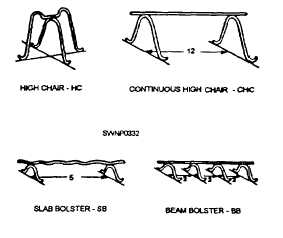reinforcing bars. About 12 pounds (5.4 kg) of wire is required to tie an average ton (0.9 tome) of bars.
NOTE: Tie wire adds nothing to the strength of the steel.
A number of different types of ties can be used with reinforcing bars; some are more effective than others. Figure 7-17 shows six types of ties that are identified below according to the letters of the alphabet used to show individual ties.
A. SNAP TIE or SIMPLE TIE. The wire is simply wrapped once around the two crossing bars in a diagonal manner with the two ends on top. These are twisted together with a pair of sidecutters until they are very tight against the bars. Then the loose ends of the wire are cut off. This tie is used mostly on floor slabs.
B. WALL TIE. This tie is made by going about 1 1/2 times around the vertical bar, then diagonally around the intersection, twisting the two ends together until the connection is tight, but without breaking the tie wire, then cutting off the excess. The wall tie is used on light vertical mats of steel.
C. DOUBLE-STRAND SINGLE TIE. This tie is a variation of the simple tie. It is especially favored for heavy work
D. SADDLE TIE. The wires pass halfway around one of the ban on either side of the crossing bar and are brought squarely or diagonally around the crossing bar with the ends twisted together and cut off. This tie is used on special locations, such as on walls.
E. SADDLE TIE WITH TWIST. This tie is a variation of the saddle tie. The tie wire is carried completely around one of the bars, then squarely across and halfway around the other, either side of the crossing bars, and finally brought together and twisted either squarely or diagonally across. The saddle tie with twist is used for heavy mats that are to be lifted by a crane.
F. CROSS TIE or FIGURE-EIGHT TIE. This type of tie has the advantage of causing little or no twist in the bars.
The proper location for the reinforcing bars is usually given on drawings (table 7-7). In order for the structure to withstand the loads it must carry, place the steel in the position shown. Secure the bars in position in such a way that concrete-placing operations will not move them. This can be accomplished by the use of the reinforcing bar supports shown in figures 7-18, 7-19, and 7-20.

Figure 7-17. - Six types of ties.

Figure 7-18. - Reinforcement bar accessories.
The proper coverage of bars in the concrete is very important to protect the bars from fire hazards, possibility of corrosion, and exposure to weather. When not specified, minimum standards given below and in figure 7-21 should be observed.
FOOTINGS-3 inches at the sides where concrete is cast against the earth and on the bottoms of footings or other principal structural members where concrete is deposited on the ground.
Continue Reading